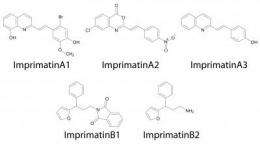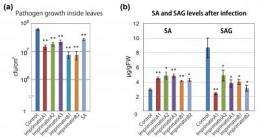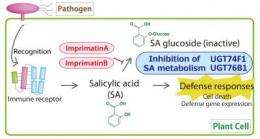Screening technique uncovers five new plant activator compounds

A new high-throughput screening technique developed by researchers at the RIKEN Plant Science Center (PSC) has been used to uncover five novel immune-priming compounds in Arabidopsis plants. Discovery of the compounds, which enhance disease resistance without impacting plant growth or crop yield, establishes the new technique as a powerful asset in the battle to protect crops from damaging pathogens.
Plant activators, compounds that activate a plant's immune system in response to invasion by pathogens, play a crucial role in crop survival by triggering a range of immune responses. Unlike pesticides, plant activators are not pathogen specific and also not affected by drug resistance, making them ideal for use in agriculture. Wet-rice farmers across East Asia use plant activators as a sustainable means to enhance crop durability without the environmental consequences of microbial pesticides.
One of the key problems of plant activators, however, is that the activation of plant responses they trigger is often associated with arrested growth and reductions in crop yield. Determining why this is so is difficult because despite their widespread use, the molecular mechanisms governing how plant activators work are largely unknown.

The new screening technique developed by the PSC team overcomes this challenge by distinguishing between compounds that induce immune responses on their own from those that do so exclusively in the presence of a pathogen. The former class of compounds, which includes known plant activators, can be toxic to cells and was thus eliminated in the screening. The resulting five compounds, identified from a total of 10,000 compounds screened, enhance resistance against pathogenic Pseudomonas bacteria by priming immune response without directly activating defense genes.

Further investigation revealed that the five compounds inhibit two enzymes that inactivate the defense hormone salicylic acid (SA glucosyltransferases or SAGTs), and gene knockout experiments confirmed that plants without these enzymes exhibit enhanced disease resistance. Together, the results establish the effectiveness of the new technique for finding useful plant activators and the power of SA metabolism as a strategy for crop protection.
More information: Yoshiteru Noutoshi, Masateru Okazaki, Tatsuya Kida, Yuta Nishina, Yoshihiko Morishita, Takumi Ogawa, Hideyuki Suzuki, Daisuke Shibata, Yusuke Jikumaru, Atsushi Hanada, Yuji Kamiya, and Ken Shirasu. Novel Plant Immune-Priming Compounds Identified via High-Throughput Chemical Screening Target Salicylic Acid Glucosyltransferases in Arabidopsis. The Plant Cell, 2012. DOI: doi/10.1105/tpc.112.098343
Journal information: Plant Cell
Provided by RIKEN


















